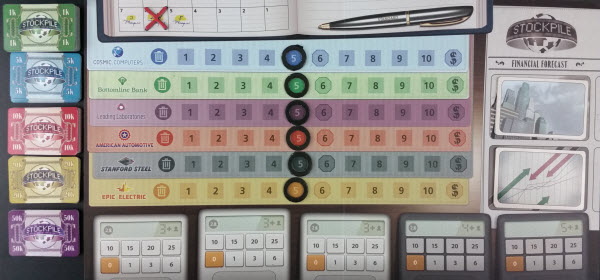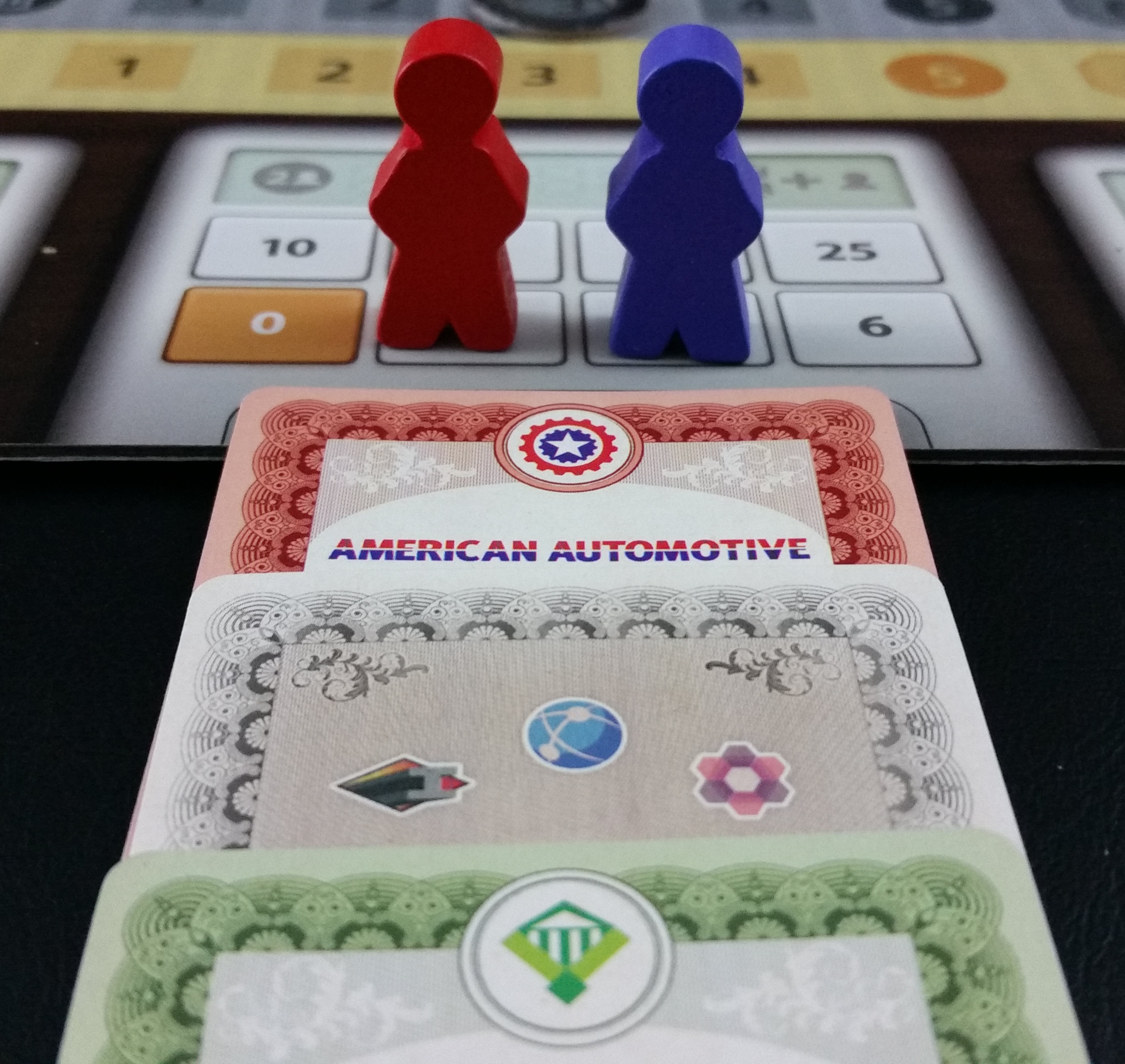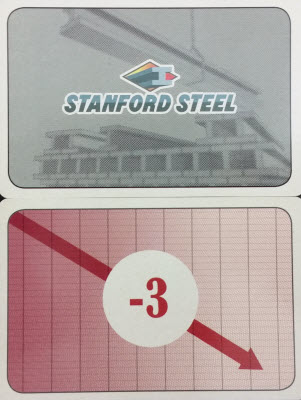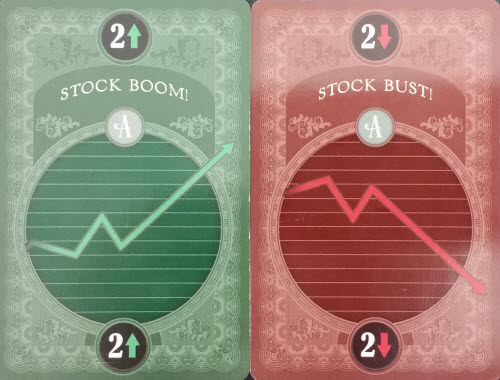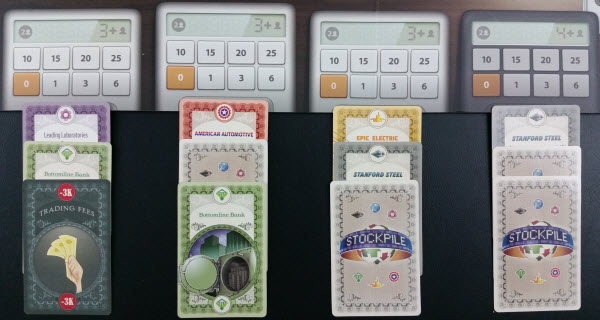Gary burst into his boss’s office slightly out of breath, his tie askew from darting through the labyrinthine maze of cubicles. “Boss, you’re going to want to hear this.”
Ms. Avery Rice looked up from her weekly forecast report at the disheveled and slightly portly man. Calmly, she put the folder down. “What is it Mr. Reed?”
“I just got word from a reliable source in Des Moines m’am. There’s going to be a major recall on Wheezey-Breeze Squeezy Cheese.
“How bad is it?”
“Pretty widespread m’am. Contaminated batches all over the country. They’re going to take a big PR hit from this.”
Avery leaned back in her chair and glanced out at the city skyline in an absent manner. It was mostly for effect of course; she had decided without hesitation. “Make the call Gary. And then do something about your tie…”
The Premise
At the height of the economic success of the 1990’s, the stock market seemed to have nowhere to go but up. Everybody wanted in on the action and would do anything to make some quick cash. As day traders with questionable ethics, players have access to insider information on how certain companies will fare and they are told to do everything they can to make a profit.
The Rules
As a lightweight economic game of financial trading, Stockpile is fairly quick to teach and even quicker to set up. The game consists of a central board, player boards, and three decks of cards: Currency, Market, and Company / Forecast.
To start, each player receives a portfolio board, starting Currency, and a Market Card (a stock) of one of the game’s six companies. Stockpile also comes with an optional set of Investor Cards that prove varying starting Currencies and a special ability. If used, each player receives a pair of them and chooses one.
Stockpile takes place over 5-7 rounds, depending on the number of players, with each round broken down into six short phases: Information, Supply, Demand, Action, Selling, and Movement. The first player is the person who paid the most for their last meal.
During Information, players receive a pair of Company and Forecast cards alongside a publicly revealed pair. These specify how a company will behave during the Movement Phase.
In Supply, players build piles of stocks to bid on – hence the name. For each player, one Market Card is placed into a new bidding column. Players receive two additional Market Cards to add to these stacks however they wish, so long as one is placed face down and the other face up. Most Market Cards are stocks, though there are also Boom / Bust cards, which adjust stocks, or Trading Fees, which force the winner of that pile to pay its penalty.
Players bid on these piles in the Demand Phase, rebidding as necessary. Once each column has a sole bidder, players pay and collect their cards.
In the Action Phase, all Boom and / or Bust cards just acquired are used. All stocks begin at a value of five but adjust over the course of the game. Anytime a company value reaches zero the company goes bankrupt, forcing players to discard all of its stock before resetting to five. Conversely, any company that reaches the end of its track “splits”, causing stocks of that company to become split stocks and double in value before the company resets to the number depicted on the board (which varies depending on whether the basic or advanced side of the board is used).
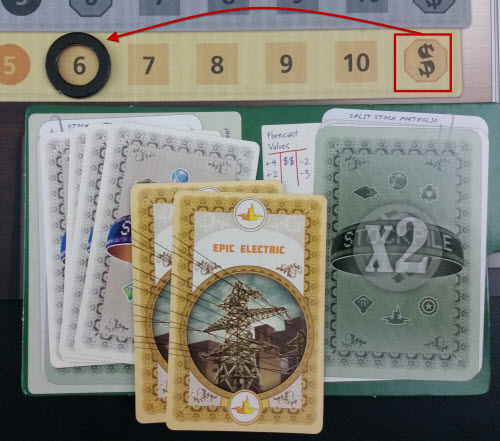
Having just split and reset, Green reveals two Epic Electric stock and moves them to the split stock side of their board.
Next, in Selling, players may sell any number of stocks. Normal stock is worth the current company value, with split stocks worth twice that amount.
Finally, in Movement, players reveal Company and Forecast cards and adjust stock values accordingly. The first player rotates and a new round begins.
After the end of the final round, players reveal their entire stock portfolio and sell back whatever they have. At that point, the person with the most money has revealed themselves to be the most efficient stockbroker and will continue to enjoy their lucrative yet morally-grey career.
Everyone else can feel justified in despising them, or calling the SEC out of spite.
Short Term Trading
For a game that generally lasts all of 45 minutes, Stockpile stuffs a respectable number of mechanics into its small briefcase. Not only does it include a typical bidding system, but it also includes room for bluffing and copious amounts of hidden information. When mixed together, the result is a game that’s both intriguing and short – not an easy combination with economic games.
Part of this is due to the simplicity of its rules. Although the rulebook is more verbose than it needs to be, it does a good job walking you through every facet of the game. Stockpile may have six different phases per round, but each is incredibly short and consists of a single action. In fact, it’s often harder for new players to remember the order of the phases more than what those phases do. To that end, Stockpile succeeds at being a game that can be taught and played quickly and easily.
Yet Stockpile’s true replayability comes from its player interaction. Unlike games where players directly affect each other, however, Stockpile’s interactivity rests with how well it leverages that hidden information.
Which is good, because Stockpile has is a lot of it.
While players collectively know how every company will behave and which Market cards are face down, you only have one piece of that knowledge at any given time. The more of that info you can figure out, the more of an advantage you have. This is achieved through deduction and guesswork, all while simultaneously trying not to tip your own hand.
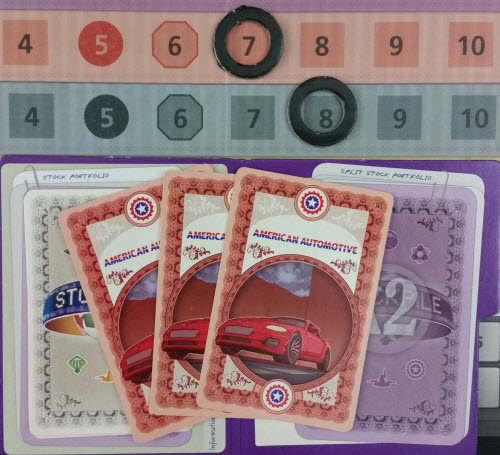
Purple sells three American Automotive stock for $7k each. Do they need money or do they know it’s about to tank?
Take selling stock, for instance. Is someone not selling a high-priced stock because they know it’s about to split, or are they just hoping it will? Knowing that two companies will always drop in value, three will rise, and one will stay the same, deciphering what other players may know based on their actions can be quite useful – not to mention profitable.
That said, in keeping with its lighter play style, Stockpile doesn’t make tracking every possible breadcrumb of information necessary, which should be reassuring to Socializers. It’s usually worthwhile to trick your opponent into buying bad stock or to figure out why they did or didn’t sell their wares, but Stockpile wisely treats learning hidden information as a bonus instead of a penalty.
Because of this financial sleuthing, not everyone will be on board. Stockpile doesn’t have a high degree of luck – it’s mostly limited to which Market Cards are drawn and how the company Forecasts are paired up – but it can feel random because of the unknown information. While this randomness helps keep the game balanced between players of different experience levels, it also makes it difficult to directly affect one another. As a result, this is a game that Strikers will divest themselves of quickly. Similarly, because there is little in the way of personal growth or expansion beyond one’s money pile, don’t expect Architects to invest in anything here.
X’s And Oh’s
Although the genre can be chock full interesting and unexpected twists, not everyone finds economic games – those centering around the acquisition of money itself – to be all that exciting. As such, economics-based games have a more limited scope of interest than similar generic themes, and many don’t always leave a lasting mark.
Stockpile is an exception.
Beyond doing a great job of encapsulating the theme of stock trading, Stockpile succeeds at distilling this theme into a form consumable by a wide cross-section of gamers. Part of this success is a result of how the game presents itself: its boards and pieces are all modern and clean, but still thematic. Even still, don’t expect this to be a game for Immersionists. Stockpile does a nice job with its basic theme, but the game will be too light on the in-game flavor Immersionists crave.
That being said, the components aren’t perfect. For one, while the player boards are standard quality cardboard, the game’s cardstock is decidedly middle-of-the-road. The various cards have basic-but-clean graphics and the money reminiscent of Monopoly, but these cards will be prone to wear after extensive use. Similarly, Stockpile comes with a set of pre-punched circles and an X-shaped token for tracking purposes. Unfortunately, their quality doesn’t measure up to the rest of the game.
A Personal Rate of Return
Visuals aside, the one real area of concern is the bidding system itself. To get the full effect of jockeying with your rivals for the best deals, everyone has to be on board. However, while Stockpile’s Demand Phase relies on players deliberately engaging with one another, it won’t directly force them to.
On the one hand, not having the game demand you immediately dive into cutthroat behavior can be disarming for new or inexperienced players, making it more approachable for casual and non-gamers while still allowing you to get a feel for the theme. (Plus, there’s nothing to say you can’t ratchet up competitive spirit as the game goes on or in subsequent sessions.)
On the other hand, this can present a bit of a problem with maintaining game tension. Because the game ensures that the number of stockpiles to bid on is always equal to the number of players, everyone is guaranteed to end up with something. Whether that’s something you’re going to want is another matter. For example, there is nothing to stop everyone in succession from simply taking the lowest opening bid of each track (being $0), and collecting their respective piles. In such cases there is effectively no bidding, no haggling, and since this act serves as the focal point of player competition for the round, it can be anticlimactic. Such a move may be completely legitimate from a mechanical standpoint, but it certainly doesn’t feel like it should be outside of the first round or so. If everyone is being methodical and merely looking for the cheapest option, you lose much of the game’s dynamic nature.
Thus, to get the full Stockpile experience players can – and should – do whatever you can to outwit their fellow brokers. This includes arranging cards during the Supply Phase so one pile is clearly not ideal for taking (i.e. having multiple face-up Trading Fees), using your placement in turn order to purposely drive up bids on each track, etc. This part of the game is as much about playing the players as it is playing the game, and Stockpile is a much richer experience if everyone takes advantage of it. Otherwise it’ll be a pretty quiet day on Wall Street.
As a result, whether Daredevils will enjoy being a hotshot investor will depend on the other players – Daredevils will only get into the game if everyone acts like they’re trying to make some quick cash versus planning for retirement.
Much the same can be said of Tacticians. Stockpile isn’t intended to be a highly complex economics affair, and planning for anything more than the next round is almost impossible. Playing with the Investor cards and the advanced asymmetrical side of the board adds some additional light strategy to keep the game from quickly becoming simplistic, but ultimately without everyone trying to outmaneuver and outwit their opponents, the light challenge that Stockpile offers will wear off for this group beyond a couple playthroughs.
The Takeaway
From the opening to closing bells, Stockpile asks players to do one thing: make the most money. Stockpile’s easy to follow rules and moderately diverse mechanics converge into a delightful 45 minute exercise of insider trading, where players can engage in stock market manipulation largely free from the ethical burdens or legal ramifications of what they’re actually doing. The game works best when players actively embrace their inner Wall Street tycoon, deciphering and leveraging its abundance of hidden information to their advantage while also trying to undermine their opponent’s profits. Yet it is never heavy-handed in asking that of players, and even in doing so Stockpile avoids moving into overt conflict. While it has minor imperfections, Stockpile is an amiable lightweight economics game whose accessibility and replayability make it a casual game that’s sure to pay dividends.
Stockpile is a product of Nauvoo Games.
Cardboard Republic Snapshot Scoring (Based on scale of 5):
Artwork: 4
Rules Clarity: 4
Replay Value: 4.5
Physical Quality: 3.5
Overall Score: 4
Photo Credits: Gordon Gekko by 20th Century Fox.

